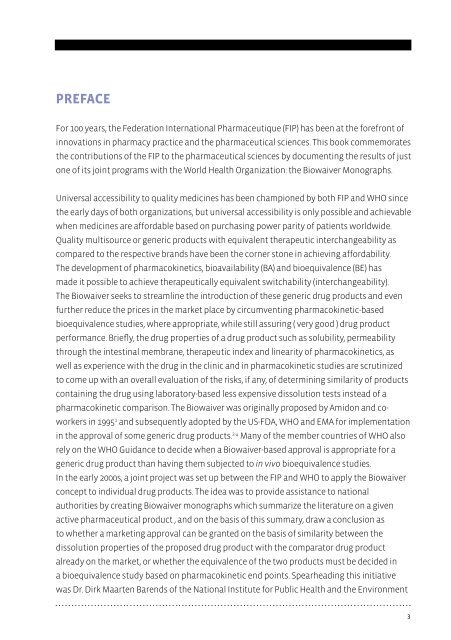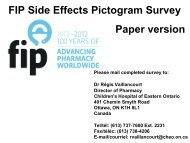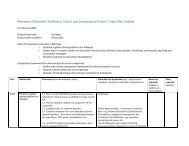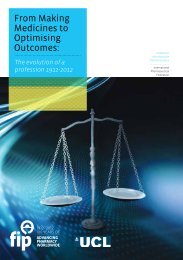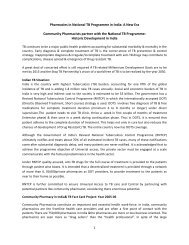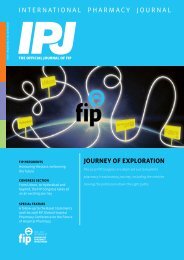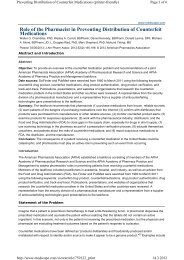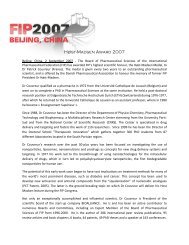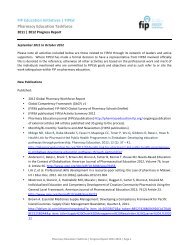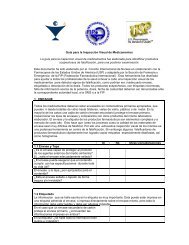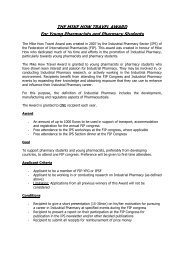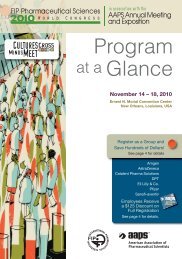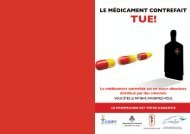THe BIOWaIVer MONOGraPHS - FIP
THe BIOWaIVer MONOGraPHS - FIP
THe BIOWaIVer MONOGraPHS - FIP
Create successful ePaper yourself
Turn your PDF publications into a flip-book with our unique Google optimized e-Paper software.
Preface<br />
For 100 years, the Federation International Pharmaceutique (<strong>FIP</strong>) has been at the forefront of<br />
innovations in pharmacy practice and the pharmaceutical sciences. This book commemorates<br />
the contributions of the <strong>FIP</strong> to the pharmaceutical sciences by documenting the results of just<br />
one of its joint programs with the World Health Organization: the Biowaiver Monographs.<br />
Universal accessibility to quality medicines has been championed by both <strong>FIP</strong> and WHO since<br />
the early days of both organizations, but universal accessibility is only possible and achievable<br />
when medicines are affordable based on purchasing power parity of patients worldwide.<br />
Quality multisource or generic products with equivalent therapeutic interchangeability as<br />
compared to the respective brands have been the corner stone in achieving affordability.<br />
The development of pharmacokinetics, bioavailability (BA) and bioequivalence (BE) has<br />
made it possible to achieve therapeutically equivalent switchability (interchangeability).<br />
The Biowaiver seeks to streamline the introduction of these generic drug products and even<br />
further reduce the prices in the market place by circumventing pharmacokinetic-based<br />
bioequivalence studies, where appropriate, while still assuring ( very good ) drug product<br />
performance. Briefly, the drug properties of a drug product such as solubility, permeability<br />
through the intestinal membrane, therapeutic index and linearity of pharmacokinetics, as<br />
well as experience with the drug in the clinic and in pharmacokinetic studies are scrutinized<br />
to come up with an overall evaluation of the risks, if any, of determining similarity of products<br />
containing the drug using laboratory-based less expensive dissolution tests instead of a<br />
pharmacokinetic comparison. The Biowaiver was originally proposed by Amidon and coworkers<br />
in 19951 and subsequently adopted by the US-FDA, WHO and EMA for implementation<br />
in the approval of some generic drug products. 2-4 Many of the member countries of WHO also<br />
rely on the WHO Guidance to decide when a Biowaiver-based approval is appropriate for a<br />
generic drug product than having them subjected to in vivo bioequivalence studies.<br />
In the early 2000s, a joint project was set up between the <strong>FIP</strong> and WHO to apply the Biowaiver<br />
concept to individual drug products. The idea was to provide assistance to national<br />
authorities by creating Biowaiver monographs which summarize the literature on a given<br />
active pharmaceutical product , and on the basis of this summary, draw a conclusion as<br />
to whether a marketing approval can be granted on the basis of similarity between the<br />
dissolution properties of the proposed drug product with the comparator drug product<br />
already on the market, or whether the equivalence of the two products must be decided in<br />
a bioequivalence study based on pharmacokinetic end points. Spearheading this initiative<br />
was Dr. Dirk Maarten Barends of the National Institute for Public Health and the Environment<br />
3


